Bennemann K.H., Ketterson J.B. Superconductivity: Volume 1: Conventional and Unconventional Superconductors; Volume 2: Novel Superconductors
Подождите немного. Документ загружается.

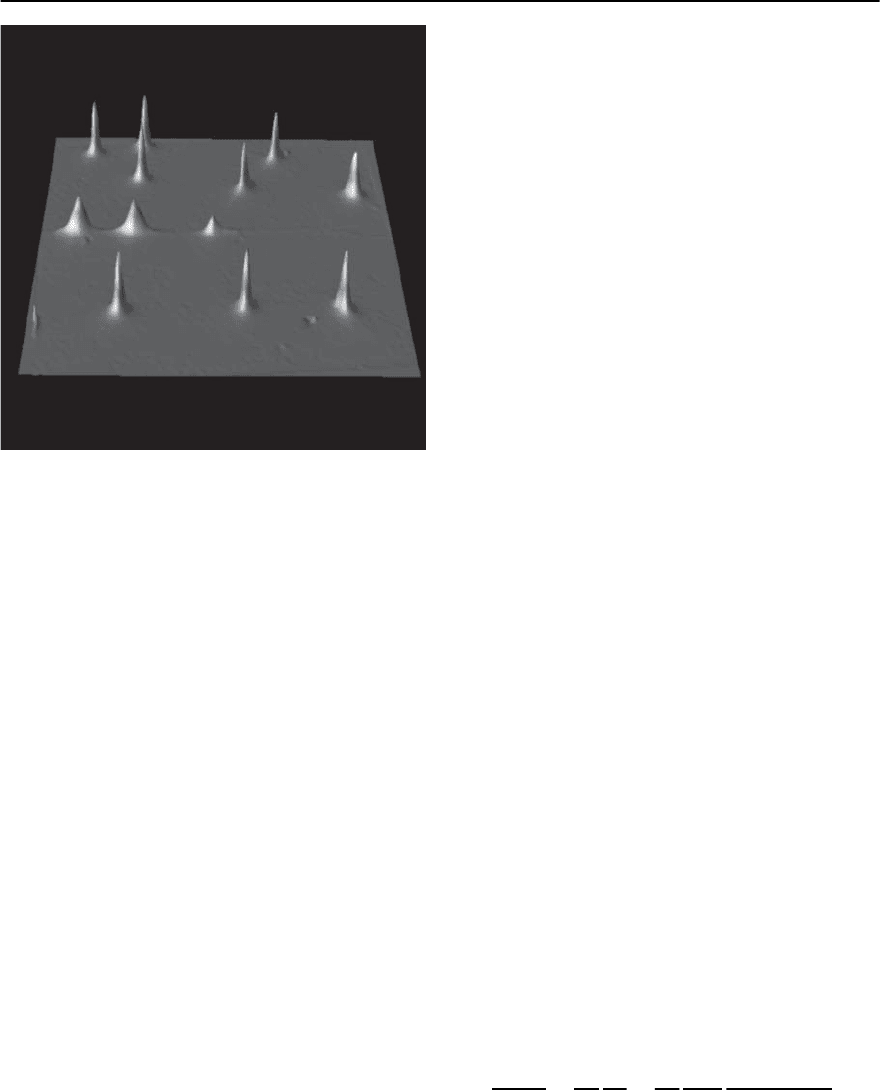
888 C. C. Tsuei and J.R. Kirtley
Fig. 16.18. Three-dimensional rendering of SQUID mi-
croscopy image of several types of vortex trapped in a
YBCO film on a tricrystal SrTiO
3
substrate designed to
generate the half-flux quantum effect in a d
x
2
−y
2 supercon-
ductor
deed,the half-flux quantum effect has been observed
directly with the SSM in tricrystal YBCO disks and
blanket films (Figs. 16.17(b) and (c) and Fig. 16.18),
in addition to rings (Fig. 16.17(a)).
Integer and Half-IntegerJosephson Vortices
The unpatterned (blanket) tricrystal sample geom-
etry has the advantage that no photolithographic
processing has to be done after the cuprate film
is deposited. It has the disadvantage that the total
flux generated at the tricrystal point is more diffi-
cult to calibrate, compared with the ring geometry.
As noted in Sect. 16.2.2, superconducting rings in-
terrupted by Josephson weak links with large values
of ˇ
e
=2LI
c
/¥
0
have total magnetic fluxes close
to N¥
0
or (N +1/2)¥
0
(N an integer), depending on
whether there is an intrinsic phase shift of 0 or
in the ring respectively. In contrast, an unpatterned
tricrystal sample has only two allowed flux states
¥ = ±¥
0
/2 atthe tricrystal pointin the frustratedge-
ometry: It is energetically favorable for higher quan-
tized flux states (e.g. ¥ = ±3¥
0
/2, ±5¥
0
/2, etc.) to
split into a half-flux quantum at the tricrystal point,
and some number of integer Josephson vortices at
a distance from the tricrystal point [121]. In fact,
Josephson vortices with flux different from ±¥
0
/2
have never been observed at the tricrystal point in a
frustrated tricrystal geometry.
Figure 16.19 compares images of a bulk vortex
(a), ¥
0
Josephson vortices trapped along the diago-
nal (b) and horizontal (c) grain boundaries, and a
¥
0
/2 half-vortex trapped at the center of a -ring
thin-film tricrystal sample of YBCO [122]. Contour
lines have been placed on the data at 0.1, 0.3, 0.5, 0.7,
and 0.9 of the full scale amplitudes. Superposed on
panel (a) is a schematic of the 4 mdiameteroctag-
onal pickup loop used for these measurements. The
dots in Fig. 16.20 are cross-sections through the im-
ages of Fig.16.19as indicated by the contrastinglines
and letters in this figure.
To date all experiments on tricrystal samples have
been done with samples with film thicknesses com-
parable to the London penetration depth. It is possi-
bletoderiveexpressionsforthefieldsfromaJoseph-
son integer or half-integer vortex in samples with
thin films [123], but these expressions are cumber-
some, and all detailed analyses of experimental data
to date have used a simpler slab model.In this picture
the(thin-film) crystals making up thetricrystal point
are modeled as semi-infinite wedges meeting at the
tricrystal line x =0,y =0,z. The phase shift (r
i
)
across the i-th grain boundary is described by the
sine-Gordonequation(16.19) [100,101].Thesolution
to (16.19) fora h/4e half-vortex with (r
i
)=0, r
i
< 0
and (r
i
)=, r
i
> 0 was given in (16.20). The so-
lution to (16.19) which describes a h/2e Josephson
vortex ((r
i
) = 0 everywhere), centered about r
i
=0
along a single grain boundary is
(r
i
)=4tan
−1
(e
r
i
/
Ji
) . (16.24)
The general expression for the phase at the tricrys-
tal point is complicated, if the grain boundaries have
different supercurrent densities, but the magnetic
flux/unit length in the i-th branch of the vortex can
be written as:
d¥ (r
i
)
dr
i
=
¥
0
2
d
dr
i
=
¥
0
2
−4a
i
Ji
e
−r
i
/
Ji
1+a
2
i
e
−2r
i
/
Ji
,
(16.25)

16 Phase-Sensitive Tests of Pairing Symmetry in Cuprate Superconductors 889
Fig. 16.19. (a)–(d) High resolution images of several
types of vortex trapped in a YBCO film on a tricrys-
tal SrTiO
3
substrate designed to generate the half-flux
quantum effect in a d
x
2
−y
2 superconductor
where in this case r
i
= 0 for all grain boundaries
at the tricrystal point, and r
i
is restricted to values
greater than 0. Inside the superconductors, the Lon-
don theory gives ∇
2
B = B/
2
L
. Using London the-
ory to describe the field inside a superconductor is
strictly valid only if no current flows through the
sample boundary. This is a reasonable approxima-
tion if
L
<<
J
. Neglecting the derivative parallel
to the grain boundaries in the Laplacian leads to
B
z
(r
i
, r
⊥
)=
¥
0
a
i
L
Ji
e
−r
i
/
Ji
1+a
2
i
e
−2r
i
/
Ji
e
−|r
i⊥
|/
L
, (16.26)
where r
i⊥
is the perpendicular distance from the i-th
grain boundary. A Josephson vortex with h/2e total
flux in it, and with a single penetration depth, has
B
z
(r
i
, r
i⊥
)=(¥
0
/2
L
J
)sech(r
i
/
J
)e
−|r
i⊥
|/
L
.
(16.27)
For the tricrystal, the a
i
’s are normalization con-
stants determined by two conditions: First, the con-
dition that the magnetic induction at the tricrystal
point varies smoothly implies that a
i
/(
Ji
(1 + a
2
i
))
is the same for each grain boundary. Second, the
total flux at the tricrystal point is given by ¥ =
i
(¥
0
/2)4tan
−1
(a
i
)=¥
0
/2.
The magnetic inductions at a height z above the
surface are determined from those at the surface by
noting that for magnetic inductions derived from a
two-dimensional current distribution,
b
z
(k
x
, k
y
, z)=exp(−
k
2
x
+ k
2
y
z)b
z
(k
x
, k
y
, 0) ,
(16.28)
where b
z
is the two-dimensional Fourier transform
of the field B
z
(r), and k
x
and k
y
are the wavevectors
in the x and y directions respectively [124]. The flux
is derived by integrating the induction over the area
of the pickup loop.The effective height of the pickup
loop above the sample surface is obtained by fitting
data from h/2e bulk vortices, which are resolution
limited since, except very close to T
c
,theLondon
penetration depth
L
is much smaller than the size
of the pickup loop. In this limit the magnetic induc-
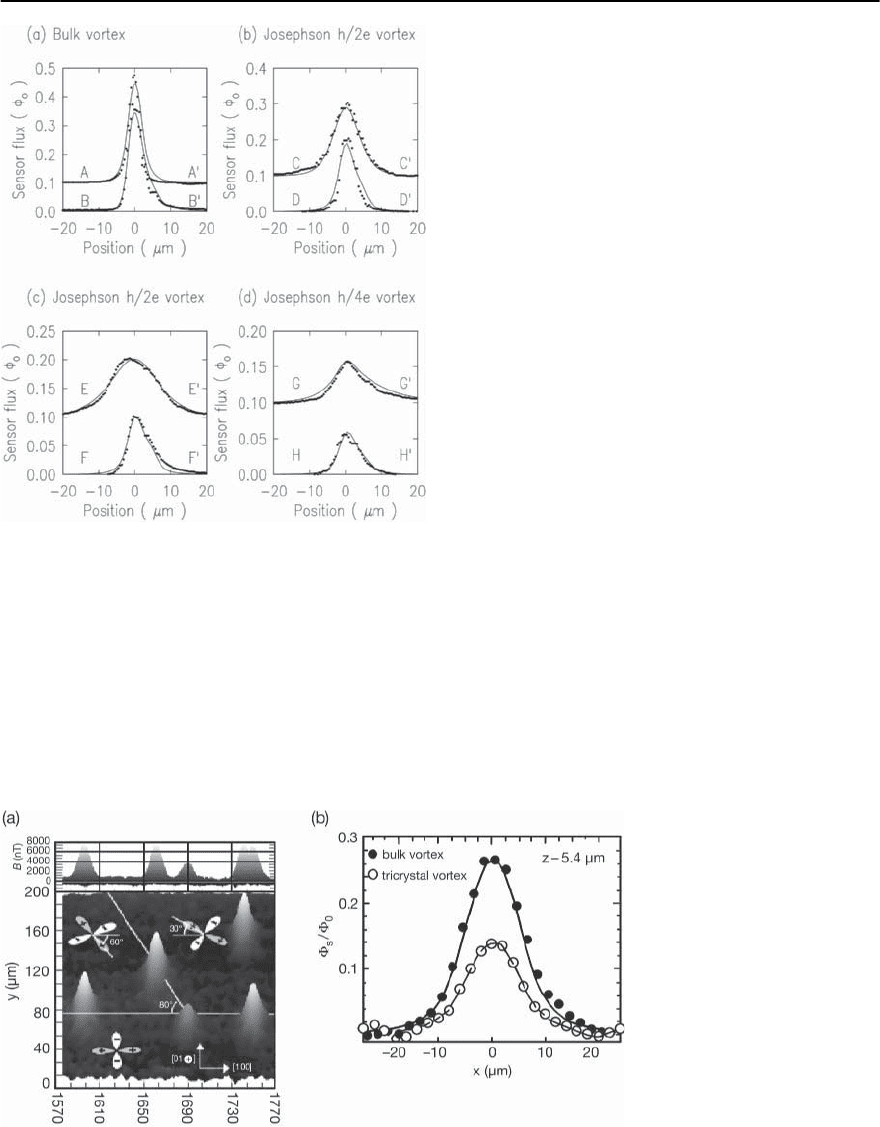
890 C. C. Tsuei and J.R. Kirtley
Fig. 16.20. (a)–(d)Thedots are cross-sections through the
vortex images of Fig. 16.19 as indicated by the contrasting
lines and letters. The lines arefitstothisdataasdescribed
in the text, assuming that the bulk vortex and Josephson
vortices along the grain boundaries have h/2e of total flux
in them,and the vortex at the tricrystalpoint has h/4e total
flux
tion in vacuum ata distancer away from the center of
a superconducting bulk vortex is given by [125–127]
B(r)=(¥
0
/2)r/ | r |
3
. (16.29)
The solid lines AA
and BB
in Fig. 16.20(a) are
fits to the data for a bulk vortex using the fields of
(16.29). The effective height determined from this fit
fixedthe height for the rest of themodeling.The solid
lines CC
− FF
in Figs.16.20(b) and (c) are fits of the
model above to the data,with
L
= 150 nm,and using
the Josephson penetration depth
J
as the only fitting
parameter. The lines GG
and HH
in Fig. 16.20(d)
are fits to the half-vortex at the tricrystal point, using
the three Josephson penetration depths as fitting pa-
rameters. This agreement between experiment and
modeling shows that there is approximately ¥
0
/2to-
tal flux at the tricrystal point. For a tricrystal sample
in a geometry that is frustrated for a d-wave super-
conductor,if the sample is cooled repeatedly in fields
close to zero,the half-fluxquantumJosephson vortex
is always present,either oriented with fields pointing
out of or into the sample.
A recent SSM flux imaging tricrystal experiment
by Iguchi’s group [128] also observed thehalf-integer
flux quantum effect (see Fig. 16.21),providing inde-
pendent phase-sensitive evidence for d-wave pairing
symmetry in YBCO.
The tricrystal magnetometry experiments di-
rectly image the half-integer flux quantum effect,
in the ground state, with a tunable geometry to en-
sure that the pairing symmetry is being probed.
Fig. 16.21. (a) Three-dimensio-
nal rendering of the magnetic
fields above an unpatterned
YBCO film on a tricrystal sub-
strate with geometry designed
to be frustrated for a d-wave
superconductor. (b)Modeling
(solid lines) and cross-section
data (symbols)forah/2evor-
tex away from the grain bound-
aries,and a h/4e Josephson vor-
texat the tricrystal point.(After
Sugimoto et al. [128])

16 Phase-Sensitive Tests of Pairing Symmetry in Cuprate Superconductors 891
There are no complications associated with self-
field effects, since no currents are applied externally.
The tricrystal ring samples have very small sample
volumes, making flux trapping highly unlikely. Any
flux trapping to occur is imaged with high sensi-
tivity. These experiments do use grain boundary
junctions, which have moderately rough interfaces.
However, care was taken to account for this interface
roughness. Further, these experiments are extremely
reproducible: dozens of samples have been made and
measured in hundreds of cool downs. All tricrystal
or tetracrystal samples that had sufficiently high
supercurrent densities across the grain boundaries
(
J
< 50m) gave results (producing either 0 or
-rings) that were as expected for predominantly
d-wave pairing symmetry.
Evidence for Pure d- Wave Pairing Symmet ry
The phase-sensitive pairing symmetry tests de-
scribed above have yielded convincing evidence for
a predominantly d-wave order parameter in YBCO.
However, none of these experiments were able to un-
ambiguously eliminate the possibility of a d+s mixed
pair state. An admixture of s-wave and d-wave pair-
ing symmetries is allowed in orthorhombic YBCO.
The orthorhombic crystal structure of YBCO is de-
rived from the inequivalent lattice distortions along
the a, b directionintheCuO
2
planes. As a conse-
quence, the relevant group symmetry for the Cu-O
rectangular lattice is C
2v
,insteadofC
4v
as appro-
priate for the Cu-O square lattice planes in cuprates
such as LSCO, Hg-1201, Tl-2201, etc.. As discussed
in Sect. 16.1.2, the s-wave and d-wave spin-singlet
order parameter symmetries belong to the same ir-
reducible representation (A
1g
) of the point group C
2v
.
Hence,the d +s mixed pairing is an unavoidable con-
sequence of orthorhombicity [80,129]. The question
is: What is the amount of the s-wave pairing in the
mixedpair state?In a (d+s)-wavesuperconductor the
order parameter (k)variesasd(k
2
x
−k
2
y
)+s(k
2
x
+k
2
y
)to
reflect theunderlying crystal lattice symmetry,where
s and d represent the size of the s-wave and d-wave
subcomponents in the admixture respectively. The
node lines ( = 0), given by k
y
= ±(
d+s
d−x
)
1/2
k
x
,ex-
ist only under the condition that the d-wave order
parameter is dominant (i.e. d/s > 1). The slope of
the node lines deviates from that of pure d-wave
k
x
= ±k
y
, the diagonals of the Brillouin zone, de-
pending on the degree of the s − d admixture.
The Pb-YBCO corner SQUID (or single Joseph-
son junction) interference experiments rely only on
a sign change of the order parameter between the
a and b faces of the YBCO single crystal, and there-
fore can not discriminate pure d-wave from d+s pair
statesaslongasd/s ≥ 1. In principle, the tricrystal
experiments with YBCO and Tl-2201 are capable of
locating the nodes on the Fermi surface of a (d+s)-
wave superconductor. However, this would require
a systematic series of tricrystal experiments based
on a knowledge of the bandstructure and a detailed
model describing the complex process of pair tun-
neling across a realistic grain boundary junction.In
the face of these difficulties in determining the de-
gree of s + d mixing in pairing, it is important to
demonstrate unambiguously the existence of a pure
d
x
2
−y
2
-wave cuprate superconductor. This is signifi-
cant in view of the substantial amount of theoretical
work [80,129] on the effect of s + d wave pairing on
the properties of cuprate superconductors, includ-
ing the origin of high temperature superconductiv-
ity. The demonstration of a pure d-wave pair state
can help to understand whether the coexistence of
d and s pairing channels is essential or just acci-
dental to high-temperature superconductivity. In the
following, phase-sensitive evidence for pure d-wave
pairing symmetry will be presented for two high-T
c
cuprate systems:
(a) Tetragonal Tl
2
Ba
2
CuO
6+ı
Stoichiometric Tl
2
Ba
2
CuO
6+ı
(Tl-2201) can be pre-
pared in the form of c-axis epitaxial films with a
tetragonal crystal structure. UnlikeYBCO,the tetrag-
onal Tl-2201 is intrinsically twin-free and has only
one CuO
2
layer per unit cell. Such a relatively sim-
ple lattice structure makes Tl-2201 a model system
for studying many normal-state and superconduct-
ing properties of the high-T
c
cuprates.
To demonstrate the existence of a pure d-
wave cuprate superconductor, a tetracrystal phase-
sensitive experiment, with tetragonal Tl-2201 [130],
adopted from a suggestion by Walker and Luettmer-
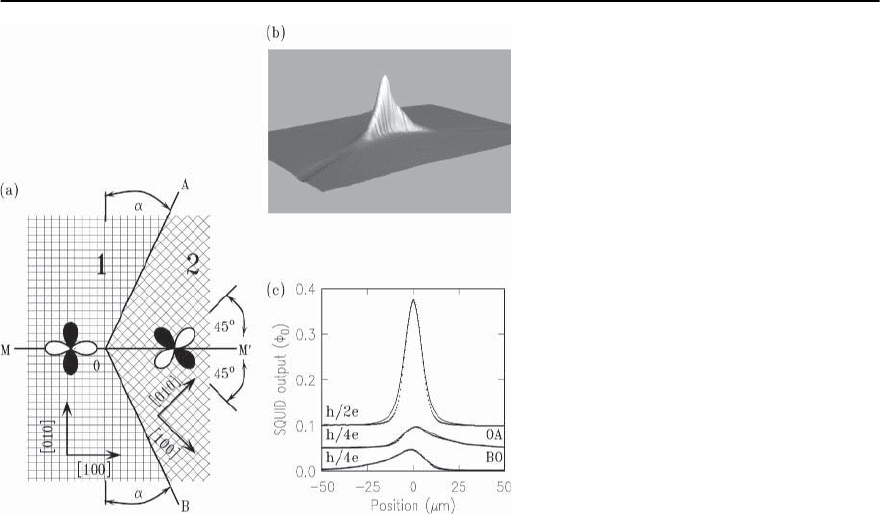
892 C. C. Tsuei and J.R. Kirtley
Fig. 16.22. (a) Tetracrystal geometry. (b) SSM
image of the crystal meeting point of a film
of Tl2201 epitaxially grown on a SrTiO
3
sub-
strate with the geometry of (a), cooled in nom-
inally zero field, and imaged at 4.2 K with an
8.2msquarepick-uploop.(c) Cross-sections
through a bulk Abrikosov vortex, and through
the half-vortex of (b), along the directions in-
dicated in (a). The dots are the experimental
data, and the solid lines are modeling, assum-
ing the Abrikosov vortex has h/2e flux trapped
in it,and the vortex at the tetracrystal point has
h/4e flux
Strathmann [80],was carriedout.Shown in Fig.16.22
is the geometrical configuration of a four-crystal
(100) SiTiO
3
substrate used in the experiment. The
zero misorientation angle at the grain boundary
MOM
makes the tetracrystal substrate effectively
a bicrystal made of two crystals rotated about the
normal (c-axis) to the substrate plane by /4 with
respect to each other. The built-in reflection sym-
metry with respect to the equal-partition line MOM
assures that,for a pair state with d
x
2
−y
2
or d
xy
symme-
try, the pair tunneling currents across the two grain
boundaries OA and OB are equal in magnitude but
opposite in sign.
(I
s
)
OA
=−(I
s
)
OB
. (16.30)
This conclusion can also be reached using the
general formula for the supercurrent of a Joseph-
son junction between two d-wave superconductors,
(16.16), [80]:
I
s
∝ C
2,2
cos(2
1
)cos(2
2
)
+S
2,2
sin(2
1
) sin(2
2
)+··· (16.31)
By reflection symmetry,theangles
1
and
2
are given
by:
1
=
+˛
−˛
,
2
=
/4−˛
/4+˛
, (16.32)
for grain boundary junctions
OA
OB
,
respectively.
When this reflection symmetry operation is ap-
plied to (16.31), every term changes its sign, reduc-
ing to (16.30). Therefore, any superconducting loop
around the tetracrystal meeting point O will be in
a -ring configuration, giving rise to the half-flux
quantum effect.On the other hand, for s-wave and g-
wave pairing symmetries, corresponding to A
1g
and
A
2g
irreducible representations respectively, there is
no sign reversal in I
s
. Standard integer flux quan-
tization is expected in any superconducting loop
enclosing the wedge tip O. Shown in Fig. 16.22(b)
is the scanning SQUID image of an epitaxial Tl-
2201 film (T
c
= 83 K) on the tetracrystal STO sub-
strate (Fig. 16.22(a)). The tetragonal crystal struc-
ture of the single phase Tl-2201 epitaxial films used
in the experiment was confirmed by micro-Raman
spectroscopy, X-ray diffraction, bright-field imag-
ing transmission electron microscopy, selected-area

16 Phase-Sensitive Tests of Pairing Symmetry in Cuprate Superconductors 893
electron diffraction, and convergent-beam electron
diffraction [131,132].A detailed modeling [122,130]
of the image data (Fig. 16.22(c)) indicates the total
amount of flux threading the wedge tip is indeed
¥
0
/2. The fact that the half-flux quantum is the only
vortex in a relatively large area suggests that it is
spontaneously generated, as expected. Since the con-
clusionaboutthesignchangeinthesupercurrentis
based on a rigorous model-independent symmetry
argument, the observation of the half-flux quantum
effect represents strong phase-sensitive evidence for
d-wave pairing symmetry in Tl-2201.
(b) Orthorhombic Bi
2
Sr
2
CaCu
2
O
ı−x
The high-T
c
superconducting systems YBCO and Bi-
2212 are probably the most investigated members
of the cuprate family, owing to their importance in
fundamental studies and practical applications.Both
are characterized by an orthorhombic layered crystal
structure. The YBCO system derives its orthorhom-
bicity from the presence of Cu-O linear chains which
distort the CuO
2
square lattice, resulting in lattice
constants a = b. In the case of Bi-2212, an incom-
mensurate superlattice modulation in the BiO layers,
along the b direction, gives rise to unequal lattice
constants a and b in the CuO
2
planes [34,133]. An
important difference between the two cuprate sys-
tems is that the in-plane Cu-O bonds coincide with
the inequivalent a-andb axes in YBCO, but not in
Bi-2212. As for the case of YBCO, early pairing sym-
metry results on Bi-2212 using quasiparticle tunnel-
ing spectroscopy and ARPES produced controversial
results, supporting s-wave as much as d-wave sym-
metry. However, more recent ARPES studies on gap
anisotropy have yielded important evidence suggest-
ing d-wave pairing symmetry in Bi-2212 [53,54,134].
A phase-sensitive experiment is needed to determine
the pair order parameter symmetry unambiguously.
The results of a tricrystal flux imaging experiment
are presented in Figs. 16.23(b) and (c). Shown in
Fig.16.23bis a scanning SQUID microscopy image of
a c-axis oriented Bi-2212 film deposited on a tricrys-
tal STO substrate designed for testing d-wave pair-
ing symmetry (the same as in Fig. 16.12). With the
tricrystal sample cooled in a field of 0.4Tandim-
aged at 4.2 K, many Abrikosov vortices are found
randomly distributed in the grains, while Joseph-
son vortices decorated the grain boundaries. At the
tricrystal point,a relatively weak vortex is always ob-
served. Detailed modeling of the SSM imaging data
shows that the vortex at the tricrystal point has a
total flux of ¥
0
/2, while all others are single vor-
tices with the full flux quantum ¥
0
(Fig. 16.23(d)).
To prove that the half-flux quantum at the tricrystal
point is indeed generated spontaneously, the sample
was cooled to 4.2 K in a nominally zero ambient field
and imaged.The fact that only the half-flux quantum
at the tricrystal point can be found(see Figs.16.23(c)
and (d)) provides the proof.
As shown in Fig. 16.24, the Brillouin zone for Bi-
2212 is rotated by exactly /4 with respect to that of
the orthorhombic YBCO. As a result, the in equiva-
lent axes a and b coincide with the node lines of the
anisotropic gap established by the ARPES measure-
ments [53,54,134]. From the viewpoint of the point
group symmetry operations, s-wave and d
x
2
−y
2
-wave
pair states correspondto two distinct irreducible rep-
resentations A
1g
and B
1g
, respectively. Therefore, Bi-
2212 can have either a pure s -wave or a pure d-wave
pairing symmetry.The resultsof the tricrystal exper-
iment and the ARPES measurements together argue
strongly in favor of a pure d-wave order parameter
symmetry for Bi-2212. This conclusion is also sup-
ported by the observation of zero [135,136] or nearly
zero [137] c-axis pair tunneling in Bi-2212.
16.3.4 Electron-Doped Cuprate Superconductors
The chemical composition of the electron-doped
cuprates [138] is given by Ln
2−x
Ce
x
CuO
4−y
,
Ln=Nd,Pr,Eu, or Sm; y0.04. Electron doping is ac-
complished by substituting the lanthanides Ln
3+
by
Ce
4+
and by removing oxygen. Of these compounds,
Nd
1.85
Ce
0.15
CuO
4−y
(NCCO) and Pr
1.85
Ce
0.15
CuO
4−y
(PCCO) have been the subjects of most studies. All
the cuprates are characterized by the Cu-O square
lattice layers in their crystal structures. However, the
electron doped ones are noted for the absence of the
apical oxygen atoms which form two-dimensional
arrays of Cu-O pyramids or octahedra with the CuO
2
planes in the hole-doped cuprates such as LCSO,
YBCO or Bi-2212. Superconductivity in electron-
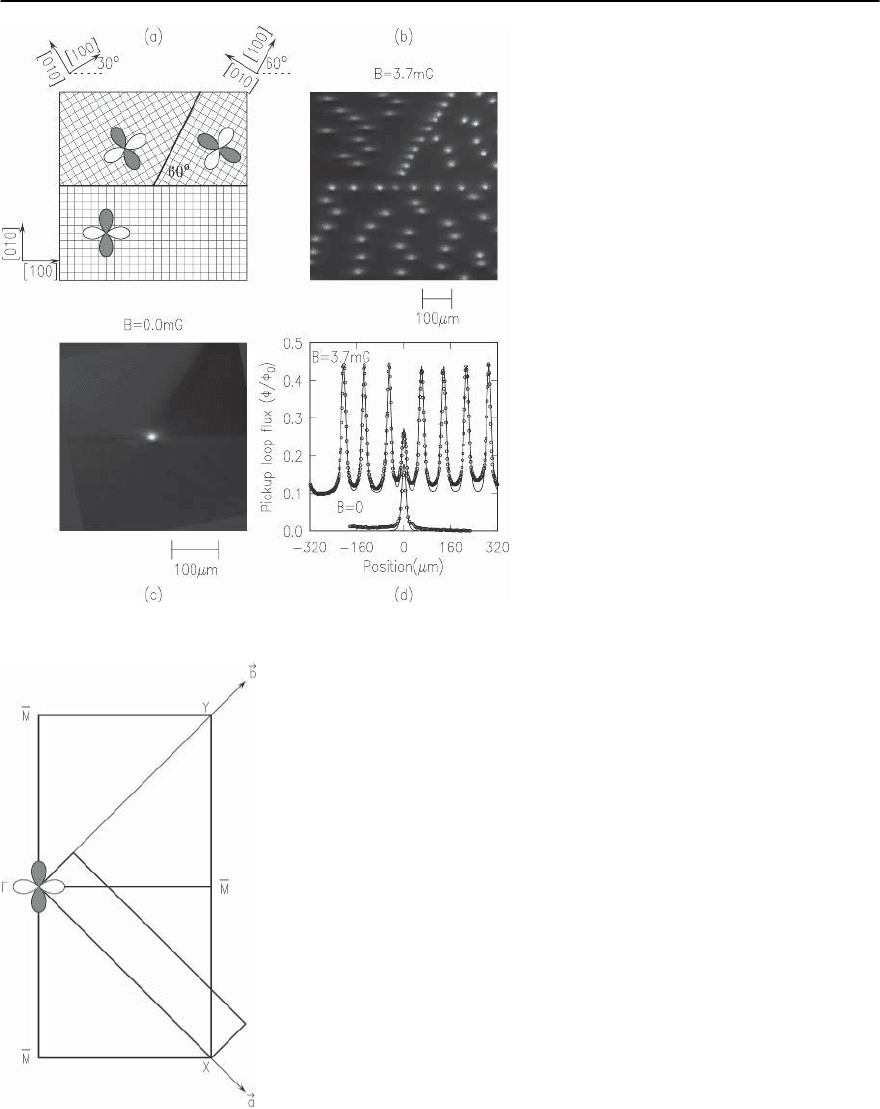
894 C. C. Tsuei and J.R. Kirtley
Fig. 16.23. SSMdata on Bi2212.(a)Tricrystalge-
ometry,including polar plots of assumed d
x
2
−y
2
order parameters aligned along the crystalline
axes. (b) SSM image of 640 × 640m
2
area of
an epitaxial film of Bi2212 on a SrTiO
3
tricrys-
tal substrate with the geometry of (a), cooled
in a field of 0.4T, and imaged at 4.2 K with an
8.2msquarepick-uploop.(c) 400 × 400m
2
image of the same sample, cooled in nominal
zero field. (d) Comparison of horizontal cross-
sections through the images (b)and(c)with
modeling assuming that all vortices have ¥
0
of
flux, except for at the tricrystal point, which has
¥
0
/2 flux spontaneously generated
Fig. 16.24. Brillouin zone for Bi2212. The reduced zone as a result of the incom-
mensurate super-lattice modulation with a period of 4.7b (b=5.41/AA) along the b
direction is outlined schematically. The orientation of the d
x
2
−y
2 -wave polar plots
is established by the ARPES data
doped cuprate systems occurs in a very narrow dop-
ing range (0.14 ≤x ≤0.17 for NCCO[138],and0.13 ≤
x ≤0.2 forPCCO [139,140]); inthe hole-doped coun-
terpart LSCO the range is broader (0.05 < x < 0.3).
The highest T
c
values in the hole-doped are over five
times those in the electron-doped cuprates. In opti-
mally doped YBCO and LSCO the in-plane resistiv-
ity exhibits a linear temperature dependence over a
wide range of temperature, with small or nearly zero
extrapolated values at T = 0. In NCCO and PCCO
(x =0.15), the in-plane resistivity is quadratic in
temperature with a large residual resistivity [141].
The results of ARPES have revealed CuO
2
-plane de-
rived flat energy bands near the Fermi surface of

16 Phase-Sensitive Tests of Pairing Symmetry in Cuprate Superconductors 895
the high-T
c
hole-doped cuprates such as YBCO [142]
and Bi-2212 [143]; but not within 300 meV of the
Fermi surface of NCCO [144]. Other physical prop-
erties such as the Hall coefficient, thermopower, and
the pressure dependence of T
c
[145], are also dif-
ferent. For more details, reviews are available in the
literature [145,146].
In view of these remarkable differences between
the hole- and electron-doped cuprates,it is only logi-
cal to expect that the pairing symmetries of these two
classes of superconductors are also different. In fact,
based on the measurements of in-plane penetration
depth
ab
, tunneling characteristics, including the
absence of zero-bias conductance peaks (ZBCP), ...,
it was indeed widely believed that NCCO and PCCO
were s-wave superconductors [147]. In recent years,
a number of new experiments and new insight into
the data analysis have cast doubts about the s-wave
conclusion for the electron-doped superconductors.
After taking into account the effect of paramagnetic
Nd
3+
ions [148], for example, a linear temperature
dependence of
ab
was found for NCCO [148–150],
expected for unconventional superconductors with
a line of nodes in the gap function. However, this
point remains controversial [151,152]. The absence
of a ZBCP in NCCO [151, 153, 154] was taken as
evidence for s-wave pairing symmetry, despite the
strong resemblance between the tunneling charac-
teristics of both types of cuprate superconductors.
Moreevidence against s-wavesymmetry comes from
the extremely small I
c
R
n
product (∼6V) observed
in c-axis pair tunneling in Pb/NCCO single crystal
junctions [155], almost three orders of magnitude
smaller than the 3 mV Ambegaokar–Baratoff limit
expected for an s-wave superconductor.
As in the case of the hole-doped cuprates,the con-
flicting results from indirect symmetry studies with
NCCO and PCCO emphasize the need for a phase-
sensitive test. Tricrystal experiments are made dif-
ficult in these materials by the extremely small su-
percurrent density across the grain boundaries. For
example, the J
c
for a [100] tilt grain boundary junc-
tion with a 30
◦
misorientation in NCCO is about
1A/cm
2
at 4.2 K, five orders of magnitude smaller
than for YBCO [156,157]. This low critical current
density leads to a very long Josephson penetration
depth, making a half-flux quantum Josephson vor-
tex at the tricrystal point difficult to observe. This
difficulty can be circumvented by making thick-film
tricrystal samples, provided that sample homogene-
ity and c-axis epitaxy can be maintained. Pulsed
laser-ablated c-axis oriented epitaxial films (∼1m
thick) of NCCO (T
c
∼22–25 K) and PCCO (T∼22–
23 K) have been developed for various tricrystal ex-
periments [158]. A J
c
of about 10A/cm
2
at 4.2 was
achieved with these thick films. Shown in Fig. 16.25a
is a SSM image of such a NCCO film deposited on
a tricrystal (100) STO substrate with the geometry
shown in Fig. 16.12 for testing d
x
2
−y
2
pairing sym-
metry regardless of whether the junction interface is
in the clean or dirty limit [87]. The Josephson vor-
tex centered at the tricrystal point spreads along the
grain boundaries for about 50m, a measure of the
Josephson penetration depth
J
.Suchalong
J
re-
sults from the small J
c
(
J
∝ J
−1/2
c
). This in turn
results in small energy barriers I
c
¥
0
/ between the
two degenerate half-flux quantum states with fields
pointing in to,and out of,the sample.Therefore small
disturbances, such as an external field as small as
0.2 mG,or theinductivecoupling betweenthe sample
and the SQUID pick-up coil, can cause the Josephson
vortex at the tricrystal point to flip to the opposite
field direction. Under any conditions of cooldown
and externally applied field there is always a vortex
at the tricrystal point. Figure 16.25a shows a three-
dimensional rendering of the SSM images obtained
by subtracting the two vortices with field directions
pointing into or out of the sample plane and dividing
by two. This procedure significantly reduces spuri-
ous signals in the SSM data. A detailed analysis of
the SSM data indicates that the Josephson vortex at
the tricrystal point has total flux ¥
0
/2 (Figs.16.25(b)
and (c)) [158]. The value of
J
from this analysis
was 48 m, corresponding to J
c
= c
2
/8ed
2
j
∼
20A/cm
2
(d=2
ab
=0.5m), in agreement with a 4-
point probe measurement. Tricrystal experiments
with NCCO in two other configurations,designed to
be unfrustrated fora d-wave superconductor,didnot
show the half-flux quantum effect. Identical results
were obtained in a series of tricrystal experiments
with PCCO [158].
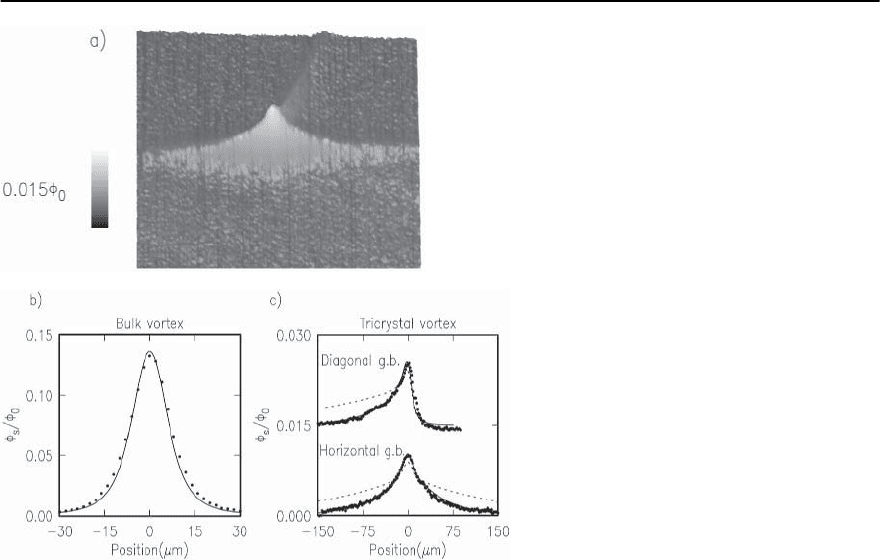
896 C. C. Tsuei and J.R. Kirtley
Fig. 16.25. (a) Scanning SQUID microscope im-
age of the central area of a tricrystal sample of
NCCO in a -ring geometry for a d
x
2
−y
2 super-
conductor, cooled and imaged in zero applied
field. (b)and(c) are modeling of a bulk vortex
(b) and two cross sections through the half-
vortex (c). The dashed curve in (c)isthebest
fit assuming a total flux of ¥
0
in the Joseph-
son vortex at the tricrystal point. The solid line,
assuming ¥
0
/2 of flux, is a much better fit
In short, the tricrystal experiments described
above have provided strong phase-sensitive evidence
for d-wave pairing symmetry in the electron-doped
superconductors NCCO and PCCO. Recently, there
has been supporting evidence for a d-wave pair-
ing state in various electron-doped cuprate super-
conductors from ARPES measurements [159, 160],
temperature dependent penetration depth measure-
ments [149,150,161], measurements of complex con-
ductivity [162], the observation of zero bias con-
ductance peaks by point contact spectroscopy [163],
SQUID characteristics [164], and low-temperature
specific heat measurements [165].
16.3.5 Thin-Film SQUID Magnetometry
Mathai etal.[106]performed pairing symmetry tests
in YBCO by imaging the flux in thin-film YBCO-Pb
(sample) SQUIDs using a scanning SQUID micro-
scope with a low-T
c
Nb-Pb (sensor) SQUID. In anal-
ogy with the experiments of Wollman et al.[104], the
sample SQUIDs had either a “corner” or “edge” con-
figuration (see, e.g. Figs. 16.8(a) and (b)): the “cor-
ner” SQUIDs should be -rings if YBCO is a d-wave
superconductor, while the “edge” SQUIDs should be
0-rings, independent of the superconducting pairing
symmetry.Thesample SQUIDs hada self-inductance
of about 75pH, and a ˇ
e
=2LI
c
/¥
0
∼ 1. This rela-
tively small ˇ
e
value meant that the spontaneous flux
and circulating supercurrents at zero external field
(see Fig. (16.5)) generated by the -ring SQUIDs
were quite small. Further, there was a large mutual
inductance between the sample and sensor SQUIDs.
Therefore the influence of the Nb-Pb sensor SQUID
on the YBCO-Pb sample SQUID screening currents
had to be corrected for in these measurements.
Rather than directly measuring the amplitudes of
the spontaneous flux at zero applied field, they mea-
sured the superconducting phase shift in their rings
by measuring the dependence of the screening cur-
rents in the YBCO-Pb sample SQUIDs as a function
of externally applied field, tracing out a number of
branches, each branch corresponding to a different
number of vortices in the YBCO-Pb sample SQUID.

16 Phase-Sensitive Tests of Pairing Symmetry in Cuprate Superconductors 897
The measurements were then repeated with the leads
to the Nb-Pb sensor SQUID and the external magnet
reversed, equivalent to a time-reversal operation. If
time-reversal symmetry invariance is satisfied, a 0-
ring YBCO-Pb sample SQUID in branch n will map
under time-reversal onto a branch n
with n = n−n
an even integer, while a -ring will have n odd.
Mathai et al. [106] found that the “corner” SQUIDs
had n odd while the “edge” SQUIDs had n even,
as expected for d-wave superconductivity. Further,
n was close to an integer for both types of sample
SQUIDs, implying that time-reversal invariance was
closely satisfied. These experiments had the advan-
tages that they directly imaging trapped flux, so that
its influence could be avoided; and they allowed a
phase shift of to be measured self-consistently us-
ing just the“corner” SQUID, without reference to the
“edge” SQUID.
Later work by Gim et al. [166] tested geometries
intermediatebetween the“corner”SQUID and“edge”
SQUID in an attempt to determine the momentum
dependence of the phase shift in the order param-
eter. In these SQUIDs one of the junction normals
was parallel to the YBCO b axis, while the other was
at an angle relative to the a axis. If YBCO were a
pure d-wave superconductor, these SQUIDs would
be expected to have a 0-phase shift for 0< <45
o
,
and a -phase shift for 45
◦
< <90
◦
. The results
of these experiments were complicated by interface
roughness introduced by the etching process used.
However, the authors concluded that the angular de-
pendence of the phase of the order parameter follows
d
x
2
−y
2
symmetry,although it was necessary to under-
stand the details of the junction fabrication process
to reach this conclusion.
16.3.6 Spontaneous Magnetization in Facetted Grain
Boundaries
Although grain boundaries in cuprate superconduc-
tors often act like conventional Josephson weak links,
an exception is seen in [001] tiltboundaries in YBCO
with very large misorientation angles, in particular
in samples with the [100] or [010] axis oriented nor-
mal to the interface on one side, with the [110] axis
normal to the interface on the other side. Anoma-
lous dependences of the Josephson critical current
on applied magnetic field have been observed in
such junctions [167,168]. These anomalies can be
understood using a model which combines d-wave
superconductivity and facetting of the grain bound-
ary.In this case the sign of the component of the gap
function normal to the local boundary line can al-
ternate from facet to facet, producing local -rings.
In such a model the Josephson currents from adja-
cent facets tend to cancel, reducing or eliminating
the normally seen maximum in the junction criti-
cal current at zero applied magnetic field, in agree-
ment with experiment. An additional implication of
this model is that magnetic fields should be spon-
taneously generated in the grain boundaries, which
act as a linear array of -rings.Thisisinfactwhat
is observed [169].An example of this effect is shown
in Fig. 16.26. The upper panel shows a SQUID mi-
croscopy image of a 0-45
◦
[001] tilt grain boundary
in YBCO. There are 4 vortices in the grains to the
right of the image, but for the most part the im-
age is dominated by spontaneous magnetization, of
both signs, in the grain boundary. The lower panel
shows a cross-section through the image along the
grain boundary. The presence of this spontaneous
magnetization in these grain boundaries, and not in
samples with lower misorientation angles, provides
additional strong evidence for d-wave superconduc-
tivity.
Mints and co-workers [170–173] have proposed
that a linear array of -rings with spacing smaller
than a local Josephson penetration depth (given by
loc
=(c¥
0
/16
2
L
<| j
c
(x) |>)
1/2
,where
L
is
the London penetration depth of the grains, and
<| j
c
(x) |> is an average of the absolute values of the
critical current densities along the facet) will exhibit
pairs of Josephson vortices, each with flux different
from ¥
0
, but with their fluxes summing to ¥
0
.The
technology for producing junctions with controlled
0and-facets, and SQUIDs with controlled 0 and
-junctions is now being developed [174–176].
16.3.7 c-Axis Josephson Tunneling
The phase-sensitive pairing symmetry tests de-
scribed above have all made use of pair tunneling
